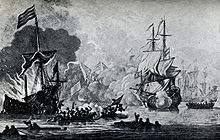Barbarian Corsairs
As Barbary Pirates (also Barbary pirates ), the Muslim privateer in the Mediterranean called that until the early 19th century from the 16th century by the as barbarism acted designated -Küste part of the North African coast.
history
background
With the decline of the economy in the Maghreb countries and the predominance of the Christian states in the Mediterranean from the 15th century, corsairism developed in the coastal cities of the Maghreb. The centers of this were the barbarian states of Algiers , Tunis and Tripoli , but the Moroccan corsair town of Salé should also be mentioned in this context. The barbarian corsairs consisted of Arabs and Moors as well as Moriscs who had fled from Spain to the Maghreb after the conclusion of the Reconquista (1492) ; in Europe they were referred to as the Saracens . In the following centuries they carried out extensive raids in the Mediterranean and far into the Atlantic , at times even on the British coast ( Cornwall ), capturing countless ships from Christian nations.
In addition, the barbarian corsairs often attacked villages and small towns located on the coast, whose inhabitants were abducted as slaves . The largest slave raids took place along the Mediterranean coast. B. the Italian Vieste and the Corsican Bastia . However, there were also raids on northern European cities: For example, the Irish port city of Baltimore and the English Penzance were attacked by Muslim corsairs. A raid in 1627 even led to Iceland at the Arctic Circle . Between 1530 and 1780 over a million Christian prisoners were taken to North Africa as slaves.
Especially in the Mediterranean Sea trade was severely affected when the corsairs recognized the Turkish sultan as overlord in 1529 and received military support for it. The most important barbarian corsairs were Arudj , Turgut Reis and Cheir ed-Din Barbarossa , who conquered Tunis in 1534, but was expelled by Charles V a year later during the Tunis campaign . With the help of the Sultan, the Spaniards were driven out of the North African area in protracted battles. During this time the pirate war between the corsairs of the barbarian states and the Christian states of the Mediterranean was at its height. The Catholic monastic orders of the Trinitarians and the Mercedarians saw their main task in the ransom or exchange of Christian prisoners or slaves from the hands of the barbarians.
In wars with Spain, the power centers of Algiers, Tunis and Tripoli were formed as the so-called barbaric states, some of which already owned the borders of today's states of Algeria , Tunisia and Libya , without, however, controlling the hinterland as it is today. Piracy was the main source of income for these states. This mischief went so far at the end of the 18th century that some European countries, such as the then independent Hanseatic city of Hamburg , but also the still young USA, committed themselves to regular payments to the governments of the barbarian states so that their merchant ships would not be bothered. This posed a problem for European merchant shipping as the constant ransom payments and the loss of shipments caused massive economic damage. In order to motivate the ship's crews to defend the cargo, propaganda was spread about the treatment of prisoners by the barbares. Soon there was extensive literature on everything that actually or allegedly happened to Christian barbarian prisoners. For example, these should be tied to the muzzle of cannons and those then fired; the atrocities were described in great detail. Miguel de Cervantes , who himself had been kidnapped by Algerian corsairs and had to work as a slave in Algiers for five years, processed his experiences in the play Los Tratos de Argel .
Decline
The decline of the corsair fleets began in the 19th century when the European naval powers such as B. England, the Netherlands and France with their fleets repeatedly took Algiers, Tunis and Tripoli under cannon fire. The United States built the first US Navy warships to put the North African corsairs in their place, and waged two wars ( American-Tripolitan War (1801-1805), American-Algerian War (1815)) with the Barbarians. The Austrian Navy undertook a successful expedition against Morocco in 1829 because of the hijacking of Austrian merchant ships . In 1827, the French King Charles X took an insignificant incident as an opportunity to declare war on Hussein , Dey of Algiers. This step was primarily due to the domestic political situation in France, which forced the king to draw public attention to the North African corsairs. However, the decisive military strike against Algiers did not take place until 1830, when King Charles X was politically at an end. The conquest of Algiers could therefore no longer stop the revolution of 1830 .
See also
literature
- Salvatore Bono: Pirates and Corsairs in the Mediterranean. Naval War, Trade, and Slavery from the 16th to 19th Centuries. Klett Cotta, Stuttgart 2009, ISBN 978-3-608-94378-8 .
- Andreas Obenaus, Eugen Pfister and Birgit Tremml (eds.): Terror of the traders and rulers: Pirate communities in history . Mandelbaum, Vienna 2012, ISBN 978-3-85476-403-8
- Adrian Tinniswood: Pirates of Barbary. Corsairs, Conquests, and Captivity in the Seventeenth-Century Mediterranean. Riverhead Books, New York 2010, ISBN 978-1-59448-774-3 .
- Magnus Ressel: Between slave coffers and Turkish passports. Northern Europe and the barbarians in the early modern period. Berlin / Boston (De Gruyter) 2012, XV, 834 pp. (Pluralization and Authority, Volume 31)
- Andreas Rieger: The sea activities of the Muslim captors as part of the state fleet during the Ottoman expansion in the Mediterranean in the 15th and 16th centuries . Hamburg, 1992, ISBN 978-3-87997-223-4 .
Web links
- Historical securities on the subject: The dear privateers
Individual evidence
- ↑ http://www.baltimore-ireland.com/heritage/sack.html
- ↑ http://www.shimbo.co.uk/towns/penzance.htm
- ↑ http://www.heimaslod.is/index.php/Der_Weg_der_türkische_Invasion The way of the Turkish invasion
- ↑ mare , issue 81, August 2010.

